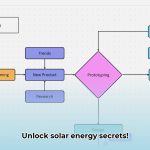Want to save serious cash and maybe even make your home worth more? Going solar might be the answer, but it can feel overwhelming. This guide takes the mystery out of it, showing you exactly how solar panels can boost your finances. We’ll walk you through everything from lower energy bills and valuable government incentives to increasing your property’s worth. It’s all about getting the biggest return on your investment and making smart choices for a sustainable future. Let’s turn your home into a money-saving, eco-friendly powerhouse! For more data on solar ROI, check out this helpful resource: Solar ROI data.
Financial Benefits of Solar Energy: Unlocking Long-Term Savings and Energy Independence for a Sustainable Future
Going solar isn’t just about helping the planet; it’s a savvy financial decision that can yield significant long-term savings and promote energy independence. Let’s explore in detail how harnessing the sun’s power can substantially enhance your financial well-being, both immediately and for decades. Solar panels typically last 25 to 30 years, providing a quarter of a century or more of clean, reliable energy.
Immediate Cost Savings: Reducing High Electricity Bills
One of the most appealing benefits of solar energy is the potential for immediate savings on your electricity bills. By generating your own power, you reduce your reliance on the grid and lessen your dependence on traditional power companies. This translates into tangible monthly savings. The precise amount you save depends on factors like your energy consumption habits, the size of your solar panel system, and local electricity rates. Even a modest solar setup can lead to a noticeable reduction in your monthly expenses. Imagine having that extra money available each month – funds you can allocate to other priorities or simply enjoy!
Long-Term Returns: A Smart Investment for Sustainable Living
Consider solar panels as a durable, long-term investment, similar to purchasing a reliable vehicle or investing in a promising stock. They typically have a lifespan of 25 to 30 years, consistently generating clean energy throughout their operational period. Over time, the cumulative savings from reduced energy costs can more than offset your initial investment. Furthermore, there’s an intrinsic value in contributing to a cleaner, greener future. This provides a sense of satisfaction that is hard to quantify financially.
Boosting Your Home’s Value: A Win-Win for Homeowners
Installing solar panels not only decreases your recurring utility bills, but it also has the potential to increase your property’s market value. Numerous studies have indicated that homes equipped with solar panels often command higher selling prices and attract buyers more quickly than comparable homes without solar installations. This enhances your home equity, providing a significant financial advantage should you decide to sell your property in the future. It’s a tangible financial benefit directly tied to your real estate investment. According to the U.S. Department of Energy, homeowners pay a premium for homes equipped with solar panels. A study by the Lawrence Berkeley National Laboratory showed that, on average, solar installations increase a home’s value by approximately $15,000.
Government Incentives: Maximizing Your Savings
Many governments at the federal, state, and local levels offer financial incentives, such as tax credits, rebates, and grants, to encourage the adoption of solar energy. These incentives can significantly reduce the initial investment required to install solar panels, making solar energy more accessible and accelerating your return on investment. For instance, the federal government offers a substantial tax credit for solar installations. Be sure to explore all available incentives in your area to maximize your savings.
Step-by-Step Guide to Solar Savings
Ready to harness the power of the sun? Here’s how to get started:
- Assess Your Energy Needs: Begin by evaluating your household’s energy consumption patterns. Review your utility bills to determine your average monthly and annual electricity usage. This information will help you determine the appropriate size of solar system for your home.
- Explore Financing Options: Investigate the various financing options available, including loans, leases, and Power Purchase Agreements (PPAs). With a PPA, a third-party company owns and maintains the solar system, and you purchase the electricity it generates at a predetermined rate. Compare the costs and benefits of each option to determine the best fit for your financial circumstances.
- Obtain Multiple Quotes from Reputable Installers: Don’t settle for the first offer you receive. Obtain quotes from several reputable solar installers in your area. Compare the quality of the equipment, warranty terms, installation costs, and overall value of each proposal.
- Factor in Government Incentives: Research and factor in any applicable federal, state, or local tax credits, rebates, or grant programs. These incentives can significantly reduce the total cost of your solar system.
- Project Your Return on Investment (ROI): Utilize online ROI calculators or consult with a financial advisor to estimate the long-term savings and financial benefits of your solar system. Consider factors such as electricity rate inflation, system performance degradation, and maintenance costs.
Navigating Potential Challenges: Addressing the Risks
While the financial advantages of solar energy are substantial, it’s crucial to be aware of potential challenges. The initial investment can be significant, although financing options can help offset this cost. Additionally, there’s the possibility of system malfunctions, although most reputable solar panel manufacturers offer comprehensive warranties. Changes in government regulations or incentives could also impact the economics of solar energy. However, many of these risks can be mitigated through careful planning and selecting a reputable installer.
Financial Benefits: A Detailed Overview
| Factor | Short-Term Benefits | Long-Term Benefits |
|---|---|---|
| Lower Energy Bills | Immediate savings on monthly electricity expenses | Consistent savings over the system’s 25-30 year lifespan |
| Higher Property Value | Increased marketability and potential selling price | Enhanced home equity and long-term appreciation |
| Government Incentives | Reduced upfront costs and tax liabilities | Potential for ongoing incentives based on system performance |
| Energy Independence | Reduced reliance on fluctuating utility prices | Greater control over energy costs and security of supply |
Actual savings may vary depending on your location, sunlight availability, energy consumption patterns, and changes in electricity prices.
Looking Ahead: A Sustainable Financial Future
The financial benefits of solar power are substantial: lower energy bills, increased property value, and access to government incentives. By transitioning to solar energy, you’re not only securing your financial future but also contributing to a cleaner, more sustainable environment. It’s an investment that benefits both your wallet and the planet. Explore your options today and discover how quickly your investment can start paying off!
How to Calculate Solar Panel ROI for Homeowners
Going solar is a smart move, but how do you know if it’s the right move for you? Let’s break down how to calculate your solar panel ROI (Return on Investment). It’s simpler than you think!
Understanding the Basics
Your solar panel ROI is the return you get on your initial investment. It’s a way to measure how quickly your system pays for itself through energy savings.
Several factors influence your ROI:
- Electricity rates: Higher rates mean faster payback.
- System size: A larger system costs more but generates more savings.
- Incentives: Federal, state, and local incentives can greatly improve your ROI. The federal solar tax credit is currently 30% of the system cost.
- Installation costs: Professional installation is more expensive than DIY.
- Panel lifespan and degradation: Panels last around 25 years, but their efficiency decreases over time, about 0.5% per year.
Step-by-Step Calculation
Here’s a simplified approach to calculating your solar savings:
- Determine your annual electricity costs: Review your utility bills.
- Estimate your solar power production: Use online calculators or installers.
- Calculate annual energy savings: Subtract what your solar will produce (kWh) from your total annual energy usage. Multiply that by your electricity rate.
- Factor in incentives: Research federal, state, and local incentives.
- Calculate your net investment: Subtract incentives from the system cost.
- Determine your payback period: Divide your net investment by your annual savings.
- Project long-term ROI: Factor in panel replacement costs and longer term projections for electricity rates.
The Impact of State Incentives
State incentives vary greatly. Some states offer tax rebates, while others have net metering programs (you get credit for excess energy fed back into the grid).
Online Tools and Professional Advice
Many online calculators provide estimates. However, for a precise analysis, consult a solar installer.
Pros and Cons
| Pros | Cons |
|---|---|
| Reduced electricity bills | High initial investment |
| Increased home value | Panel degradation over time |
| Environmental benefits | Potential for regulatory changes |
| Long-term cost savings | Dependence on sunlight; weather-dependent |
| Government incentives | Inverter replacement costs |
Disclaimer: These calculations are estimates. Always consult a professional.
Maximizing Solar Energy Return on Investment for Commercial Properties
Before maximizing your solar ROI, assess your energy usage with a comprehensive energy audit.
System Design and Sizing
The right system size is critical. Your energy audit data will allow your installer to design a perfectly sized system.
Financing Options
- Direct Purchase: Full ownership, tax credits, and depreciation benefits, but a larger upfront investment.
- Power Purchase Agreement (PPA): Lower monthly rate for energy produced, minimizing initial investment.
- Lease: Similar to a PPA, but less control over maintenance and upgrades.
The best option depends on your financial goals, risk tolerance, and cash flow.
Government Incentives
Government incentives substantially improve ROI. The federal Investment Tax Credit (ITC) is a key factor, as are state rebates and net metering policies.
Long-Term Maintenance and Monitoring
Regular inspections and cleaning are essential to prevent costly repairs.
Risk Mitigation
Mitigating risks includes addressing unexpected installation costs, production yields and changes in incentives.
Calculating Your Projected ROI
Calculate ROI with the assistance of a financial professional. A thorough ROI projection factors in system costs, savings, incentives, and potential property value appreciation.
Residential Solar Panel ROI: The Impact of Location and Energy Consumption
Thinking about going solar? Let’s explore how location and energy consumption affect your ROI.
The Importance of Location
Sunlight is your solar panels’ fuel. Sunny areas generate more power, leading to faster payback. Location also impacts electricity prices. Higher rates mean greater savings.
How Energy Consumption Impacts ROI
Your home’s energy use impacts your solar panel needs and thus, your ROI. Consider your household’s energy habits.
Step-by-Step ROI Calculation
- Assess your energy consumption: Review your bills.
- Get professional quotes: Contact several solar installers.
- Research incentives: Explore incentives like tax credits and rebates.
- Analyze the proposals: Focus on system size, warranty, and total costs.
- Project your savings: Use online calculators or consult installers.
- Factor in home value appreciation: Homes with solar panels often command higher sale prices.
- Account for maintenance costs: Plan for maintenance over the panels’ lifespan.
Pros and Cons
| Pros | Cons |
|---|---|
| Reduced energy bills | Significant upfront costs |
| Increased home value | Dependence on sunlight; less effective in cloudy climates |
| Environmental benefits | Potential for system malfunctions; requiring maintenance and repairs |
| Long-term savings and ROI | Changes to government incentives can impact long-term projections |
| Reduced dependence on fossil fuels | Permitting and installation processes can sometimes be time-consuming |
Navigating the Risks
Mitigate risks by securing financing, choosing quality panels, conducting site assessments, and creating a maintenance plan.
- Wind Energy Vehicle: Cars Powered by Wind—The Future is Near? - December 5, 2025
- Wind Energy Powered Cars: Are They the Future of Driving? - December 3, 2025
- Wind Energy in Cars: Is This the Future? - November 30, 2025
















